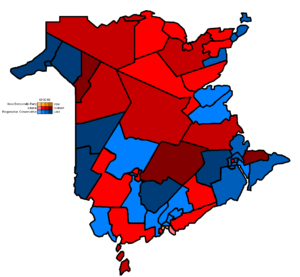| |||||||||||||||||||||||||||||||||||||||||||||||||
55 seats of the Legislative Assembly of New Brunswick 28 seats needed for a majority | |||||||||||||||||||||||||||||||||||||||||||||||||
|---|---|---|---|---|---|---|---|---|---|---|---|---|---|---|---|---|---|---|---|---|---|---|---|---|---|---|---|---|---|---|---|---|---|---|---|---|---|---|---|---|---|---|---|---|---|---|---|---|---|
| Turnout | 68.67% [1] | ||||||||||||||||||||||||||||||||||||||||||||||||
| |||||||||||||||||||||||||||||||||||||||||||||||||
 Map of New Brunswick's ridings coloured in based on the winning parties and their popular vote | |||||||||||||||||||||||||||||||||||||||||||||||||
| |||||||||||||||||||||||||||||||||||||||||||||||||
Preview warning: Page using Template:Infobox election with unknown parameter "next_mps"

Progressive Conservatives (28)
Liberals (26)
New Democrats (1)
The 2003 New Brunswick general election was held on June 9, 2003, to elect 55 members to the 55th New Brunswick Legislative Assembly. Although polls initially suggested a landslide victory for Premier Bernard Lord's Progressive Conservative Party of New Brunswick, the dynamics of the race shifted after Shawn Graham, leader of the Liberal Party of New Brunswick, took on auto insurance rates as a key issue of his campaign. Lord and the Progressive Conservatives were ultimately re-elected by a narrow margin of just 2 seats.
- ^ Elections New Brunswick, Canada (February 5, 2014). "Provincial Election Results - Elections NB". www.electionsnb.ca.

